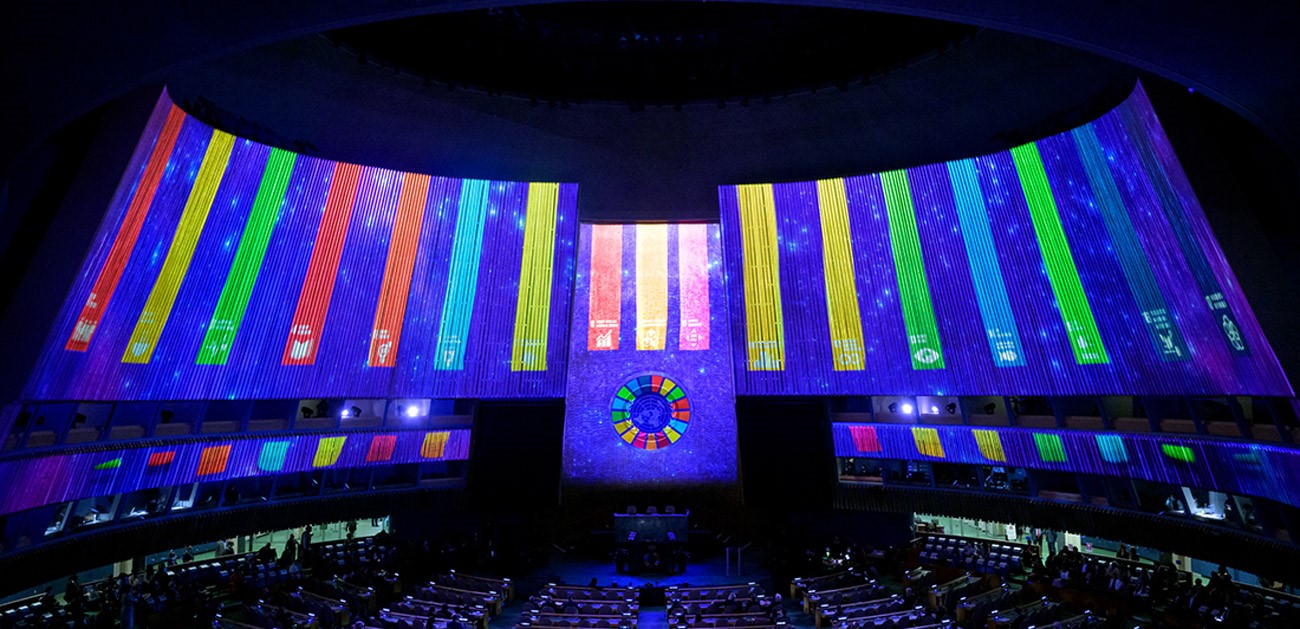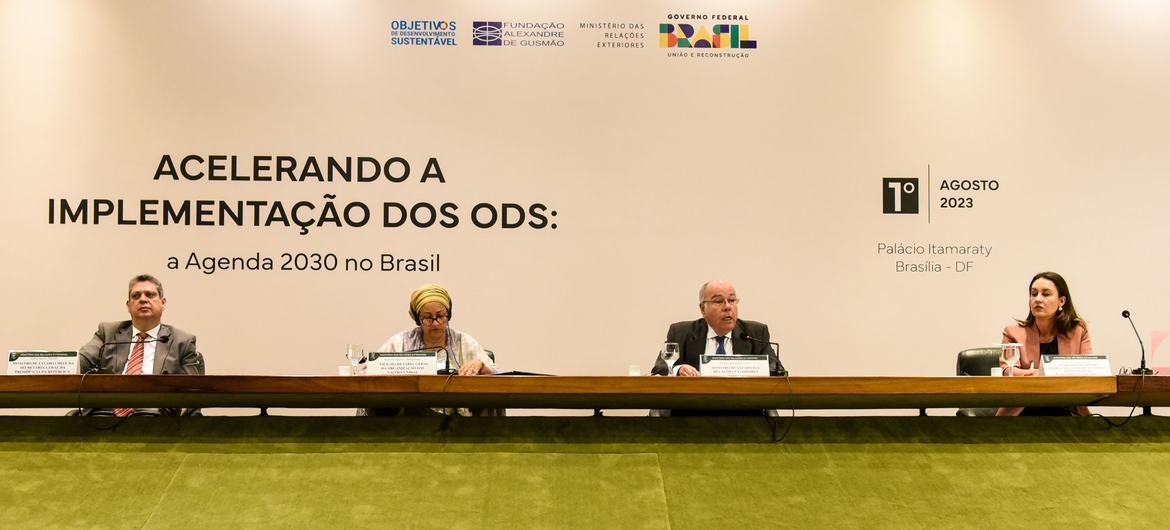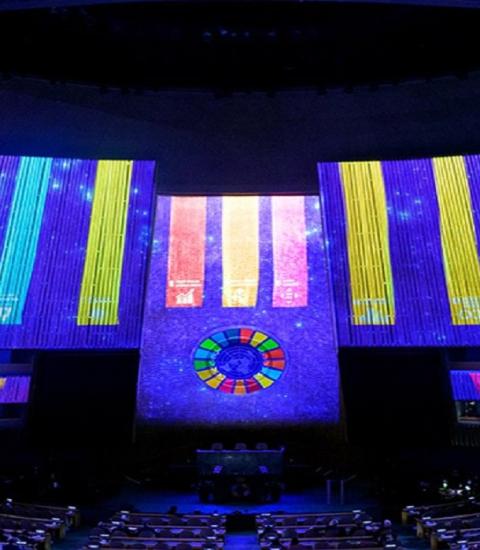[By Prof. Bharat H. Desai]
Introduction
Csaba Kőrösi, the President of the United Nations General Assembly (UNGA) has invited1 (program; letter of July 17, 2023) the Heads of State and Government (HoS&G) for the 2023 High-level political forum on sustainable development2 under the auspices of the UNGA’s 2023 SDG Summit (September 18-19, 2023)3. It holds significance as a mid-point (2015-2030) of the Sustainable Development Goals (SDGs)4 that were unveiled with a mission for: Transforming Our World. The 2023 SDG Summit is a last-ditch effort to address the “impact of multiple and interlocking crises facing the world”. It was adopted vide UNGA resolution 70/1 of September 25, 20155. This global summit will also coincide with the commencement of the 78th session6 of the UNGA (2023-24).

The UNGA Plenary Hall: An Illuminated Color Web of 17 SDGs [Source: UN Photo/Manuel Elias]
The Season of Summits
Thus, it seems, third week of September will witness all roads leading to the 78th UNGA in New York. The 2030 SDGs were adopted after marathon negotiations mandated by the 2012 Rio+20 Summit7. This epoch-making instrument was built on the previous cycle of 2015 Millennium Development Goals (MDGs)8. It vividly underscored role of the UNGA, literally and metaphorically, as the conductor of a grand orchestra9 to diagnose global problematique, propound an action plan and exhort the sovereign states to earnestly pursue it. As the plenary organ of the UN, the Assembly has sought to provide both legitimacy and direction to various inter-governmental processes for institutionalized international cooperation. In a way, the SDGs provide an audacity of hope as well as a way of atonement for the Commission of Sustainable Development (1992-2012)10 that faded away without a tear being shed.

UN Deputy Secretary-General at the SDG Meeting in Brasilia, August 1, 2023 (Source: UN News; Gustavo Magalhães/MRE)
As a part of series of preparatory processes, on August 01, 2023, the UN Deputy Secretary-General, Amina Mohammed addressed a meeting on 2030 SDGs in Brazil11. She stressed on the importance of the 2023 SDG Summit. “The Secretary-General is urging leaders to come to the UN General Assembly and the SDG Summit in September ready to contribute to a Rescue Plan for People and Planet. This means arriving with concrete national commitments and action plans to accelerate progress towards the SDGs,” the UN Deputy S-G said.
Lofty Goals for People and Planet
The forthcoming 2023 SDG Summit12 shall have to undertake a serious review of prospects for realizing the Goals in the next seven years (2023-30). The SDGs were to be realized in an incremental and persuasive way in consonance with political convenience of the UN member states. The Goals necessitated a major rejig of the global order, economy, societal structures, wasteful consumption patterns, unsustainable lifestyles and pervasive mindsets. At the SDG inauguration in 2015 (70th UNGA), terming the Agenda 2030 as “lofty”, the Indian Prime Minister Narendra Modi observed: “Sustainable development of one-sixth of humanity (India) will be of great consequence to the world and our beautiful planet”13. However, the era of planetary crisis calls for a decisive course correction as the galloping human population [projected to reach 9.8 billion (2050) and 11.2 billion (2100)]14 will require natural resources equivalent of three planets to sustain current profligate lifestyles. In the face of this challenge, the SDGs seem to be utopian goals for people, planet, prosperity, peace and partnership.
In a way, the SDGs underscore tragedy of the unfettered human quest for material progress. The usage of prefix sustainable provides value to the cherished targets, seeks to circumscribe inherent greed for development and fine tune relevance of sustainability in a rapidly changing world. The SDGs include challenges as diverse as inequality in living standards, infrastructure, water & sanitation, women empowerment, access to modern energy, quality education, healthy lives, poverty and hunger. Its preamble makes an emphatic assertion that “eradicating poverty in all its forms and dimensions, including extreme poverty, is the greatest global challenge and an indispensable requirement for sustainable development”. Does the audacious claim of not leaving anyone behind in that journey conjure up scenario of chasing a mirage in a world that is so unjust, inequitable and full of contradictions? As a result, the Goals inherently face an uphill task of matching grim reality with high expectations. Since 2000, two back-to-back global processes for MDGs (2000-2015)15 and SDGs (2015-2030)16 do underscore that there are Limits to Growth17 on this beleaguered planet. There is a legal quibbling over SDGs’ normative value. Still the SDGs provide a beacon of hope as sustainability agenda has risen like the proverbial Sphinx from in the aftermath of the 1992 Rio18 and the 2012 Rio+2019 Summits (see UNGA’s Role; Figure by the author).

SDGs and the Global Disorder
As the HoS&G are set to take stock at the 2023 SDG Summit, the global order is in a perilous state. Apart from the havoc brought about by the Covid-19 pandemic (2020-2022), there are grave crisis signals that all the 17 Goals (169 targets) aimed at “leaving no one behind” are likely to go haywire. In that eventuality, there is a danger of SDGs meeting the fate of MDGs. Therefore, it is pertinent – in the scholarly realm – to take cognizance of some of the main contributing factors, events, situations and contingencies that could upturn the SDG applecart. These include: (i) World Without Glaciers: There are warnings about shrinking of the world’s ‘water towers’ (glaciers) that would affect availability of fresh water resources around the world. The UNSG has warned (March 22, 2023)20 that “Human activity is driving our planet’s temperature to dangerous new heights…turning glaciers, into the canary in the coalmine…Losing these giants would be a giant problem for our world”. (ii) Global Humanitarian Crisis: According to the UN Global Humanitarian Overview 202321, one in 23 people on the planet Earth needs help in order to survive. A record 339 million people need humanitarian assistance22. The UN Office for the Coordination of Humanitarian Affairs (UNOCHA) has been under severe stress since never before the humanitarians were called to respond to this level of need and in much more risky environments. The OCHA’s Strategic Plan 2023-2026 has provided warning signs that “By 2026, needs are set to far outpace resources, leaving an inundated humanitarian system struggling to meet a mere fraction of needs”23. The estimated funding requirement for the UN’s humanitarian projects has been pegged at 50 billion US dollars. (iii) Extreme Climatic Events: The WMO’s State of Global Climate 202224shows the planetary scale changes on land, in the ocean and in the atmosphere caused by record levels of heat-trapping GHGs25. The last eight years (2015 to 2022) were the warmest on record. In fact, the extreme climatic events alone drove an estimated 16 million people into food crises in 15 countries. It also caused an exacerbated violence against women and children. It is likely to reach 100 million in coming years. (iv) Exacerbated Global Poverty: The Multidimensional Poverty Index 202226 provided estimate of 1.2 billion people in 111 developing countries living in acute multidimensional poverty. The largest number of poor people live in Sub-Saharan Africa (579 million) and South Asia (385 million). It shows that central thrust of the SDGs for “eradicating poverty in all its forms and dimensions” is in serious jeopardy. (v) Violence Against Women (VAW): UnWomen data shows an estimated 736 million women – almost one in three – have been subjected to physical and/or sexual violence at least once in their life27. It does not include sexual harassment. In 2021, in the EU alone, the cost of sexual and gender-based violence (SGBV)28 was estimated around €366 billion a year, out of which VAW constitutes 79 per cent (€289 billion). (vi) Nuclear weapons have grown: There are nine nuclear-armed states (the USA, Russia, the UK, France, China, India, Pakistan, Israel and the North Korea). Out of the total inventory of an estimated 12705 warheads29 at the start of 2022, about 9440 were in military stockpiles for potential use. (vii) People Living in Conflict Zones: In a May 19, 2022 address to the UNSC30, the UNSG expressed concern for some 60 percent of the world’s undernourished people living in the conflict zones. An estimated one-fourth of global population (2 billion) live in conflicts raging across Africa, Middle East, Latin America, Asia and Eastern Europe.
SDG Stimulus & Rescue Plan
Notwithstanding above grim global disorderly scenario, in February 2023, the UNSG has launched SDG Stimulus to Deliver Agenda 203031. It graphically states that, as of November 2022, “37 out of 69 of the world’s poorest countries were either at high risk or already in debt distress, while one in four middle-income countries, which host the majority of the extreme poor, were at high risk of fiscal crisis. The burden of debt overhang is battering the economies of many developing countries”. It is estimated that by 2030, an additional 175 million, including 89 million women and girls, would fall into the debt induced distress. Thus, a “great finance divide” threatens the SDG targets since ability of poorer countries has been sharply curtailed to invest in recovery, climate action, and sustainable development. As a consequence, the Zero Draft of the Political Declaration (June 08, 2023)32, to be adopted at the High-level Political Forum on Sustainable Development (HLPF), under the auspices of the General Assembly’s mandated 2023 SDG Summit, does note the ominous ground reality that “only 12 per cent of the SDGs are on track and 30 per cent remain unchanged or below the 2015 baseline. The progress on most of the SDGs is either moving much too slowly or has regressed”.
In view of the above, it remains to be seen as to how far the 2023 SDG Stimulus call for financing for sustainable development materializes – at least $500 billion per year (concessional and non-concessional finance). Will the SDGs become an instrument to propel inter-governmental behavioral change, provide a roadmap for our salvation and become a harbinger of a new world bereft of misery? This posits the biggest challenge of the 21st century. It calls for walking-the-talk of grappling with the mirage of human development on the bedrock of ‘sustainability’. In view of the gravity of the crisis, it would be advisable if the 2023 SDG Summit considers concrete alternative pathways to meet basic aspirations of people in the disadvantaged parts of the world. It would require a radical departure from the current passivity – akin to the popular saga wherein Nero fiddled while Rome burned.
Conclusion: Audacity of Hope
In the midst of a planetary level crisis (see Bharat H. Desai, SIS Blog Special (March 29, 2023) – I and II33 and Green Diplomacy (Feb. 14, 2023)34], it is an audacity of hope to expect that the New York assembling of the HoS&G (September 18-19, 2023)35 would pay heed to the emergency button pushed by the UNSG (Stockholm+50; June 02, 2022) and ensure that the SDGs do not remain “hot air” and we decisively “end our senseless and suicidal war against nature”36. The 2023 SDG Summit outcome would also impinge upon the prospects for the Summit of the Future to be held in New York during 22-23 September 202437. Ironically, the Zero Draft of the Political Declaration (June 08, 2023) merely provides a vague promise that: “We will endeavour to reach the furthest behind first”. Therefore, it remains to be seen as to how far the HoS&G will be able to walk-the-talk on their commitment “to bold, ambitious, accelerated and transformative actions” to attain sustainable world for people and planet. It would require an audacity of hope against hope and a miracle to realize all the SDGs seven years from now (2023-2030). The countdown would be a litmus test for all the right-thinking peoples and their nations to stand by the planet Earth.




